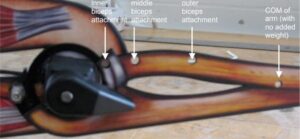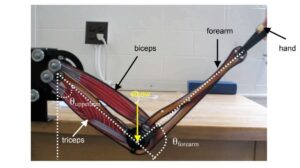
To install StudyMoose App tap and then “Add to Home Screen”
Save to my list
Remove from my list
Understanding the intricate interplay between forces and torques is crucial in comprehending the mechanics of the human body. Human motion involves multiple pivot points, each subject to various forces and torques stemming from muscle actions and the weight of body parts. Even a seemingly simple action like standing necessitates a delicate equilibrium of forces and torques across each vertebra of the spine, highlighting the complexity of biomechanical interactions within the human body. This laboratory session is designed to delve deeper into the dynamics of the human arm, honing in on the 2D motion specifically around the elbow joint.
In this exploration, our objective is to unravel the underlying principles governing biomechanics, particularly focusing on torque dynamics within the human arm.
By simplifying the model to exclude shoulder and wrist motion, as well as muscle twisting, we aim to isolate and analyze the fundamental mechanisms at play. Through a systematic examination of torque and force interactions, we seek to elucidate how these factors contribute to the overall functionality and movement of the human arm.
By leveraging tools and equipment such as the Pasco Human Arm Model, force probes, and angle sensors, we can conduct precise experiments to measure and analyze torque dynamics.
This experimental approach allows us to observe and quantify the effects of different variables, such as muscle attachment points and weight distribution, on the torque exerted by the human arm. Through hands-on experimentation and data analysis, we aim to gain a deeper understanding of the intricate relationship between forces, torques, and human movement.
Traditionally, the realm of motion analysis has predominantly focused on linear forces, emphasizing the significance of magnitude and direction in determining the resultant motion of objects.
However, the introduction of torque as a pivotal concept in mechanics brings forth a paradigm shift, highlighting the nuanced role of force application points. Unlike linear forces where the point of application is often inconsequential, torques heavily rely on the specific location where the force is exerted.
In elucidating the intricacies of torque, extended free-body diagrams emerge as indispensable tools. These diagrams provide a comprehensive visual representation, intricately mapping out the precise points of force application on an object. By extending beyond the conventional depiction of forces as mere vectors, these diagrams offer a detailed insight into the spatial distribution of forces and their rotational effects. Thus, they serve as a vital aid in unraveling the complex dynamics inherent in torque analysis.
The Pasco Human Arm Model offers a multifaceted approach to studying torque phenomena. By meticulously examining each component, we can unravel the nuanced interactions between forces and torques within the human arm.
The integration of these components within the Pasco Human Arm Model provides a conducive environment for conducting comprehensive torque analyses. By employing advanced measurement techniques and data acquisition tools, we can accurately quantify and assess the magnitude and direction of torques generated during simulated arm movements.
A key focus of our experimentation lies in understanding how different attachment points of the biceps muscle influence the force exerted by the muscle. Through systematic manipulation and precise measurements, we aim to elucidate the relationship between attachment location and muscle force output. This investigation holds significant implications for enhancing our understanding of biomechanical principles underlying arm motion and stability, with potential applications spanning sports science, rehabilitation, and ergonomics.


Prior to engaging in experimental procedures, we employ predictive modeling to anticipate the effects of different attachment locations on muscle force. Drawing upon established principles of biomechanics, we formulate hypotheses regarding the expected force exerted by the biceps muscle under varying conditions. These hypotheses serve as a guiding framework for our experimental design, facilitating structured data collection and analysis. Subsequently, through rigorous experimentation and precise measurements, we seek to verify these predictions and validate our theoretical understanding of the interplay between attachment location and force generation. This combined approach of predictive modeling and experimental verification not only enhances the robustness of our findings but also provides valuable insights into the underlying biomechanical mechanisms governing torque dynamics in the human arm.
By systematically varying the attachment points of the biceps muscle and recording the resulting hand displacement and muscle contraction, we aim to gain profound insights into the functional implications of muscle attachment locations. Through precise measurements and careful analysis, we endeavor to elucidate how different attachment points influence muscle mechanics and overall limb movement.
This in-depth examination holds immense significance in advancing our understanding of biomechanics, offering valuable insights into the complex interplay between muscle structure, attachment points, and functional capabilities. Furthermore, the findings derived from this exploration may have profound implications across various fields, including sports science, physical therapy, and ergonomic design, paving the way for innovations aimed at optimizing human performance and enhancing quality of life.
In this final phase, we refine our human arm model to account for more realistic anatomical considerations. By incorporating factors such as the angle of muscle attachment and the distribution of muscle forces, we aim to enhance the fidelity of our model. The refined human arm model holds immense potential for various applications, ranging from ergonomic design and rehabilitation engineering to sports performance analysis and medical device development. By providing a more accurate platform for experimentation and analysis, it opens up new avenues for innovation and discovery in the field of biomechanics.
This laboratory investigation has been instrumental in unraveling the intricate biomechanical principles governing human motion, particularly in the context of torque dynamics within the human arm. Through a meticulous examination of forces, torques, and muscle actions, we have not only expanded our theoretical understanding but also gained practical insights into the mechanics that dictate arm movement.
The comprehensive nature of our exploration has shed light on the multifaceted interplay between various physiological factors and mechanical forces, offering valuable insights into the underlying mechanisms of human motion. By dissecting this complex interplay, we have deepened our comprehension of the intricate balance between muscular contractions, joint movements, and external forces, all of which contribute to the seamless functioning of the human arm.
The insights gleaned from this laboratory session pave the way for the development of more sophisticated models and methodologies for analyzing and understanding human biomechanics. By integrating these insights into computational models and experimental protocols, we can refine our understanding of human movement dynamics and contribute to the development of novel interventions and technologies aimed at enhancing human performance and well-being.
In conclusion, this laboratory investigation represents a significant milestone in our quest to unravel the complexities of human biomechanics. It underscores the importance of interdisciplinary approaches in studying human movement and highlights the potential for future advancements in the field. As we continue to explore and expand our understanding of torque dynamics in the human arm, we are poised to unlock new frontiers in biomechanical research and pave the way for transformative innovations in human health and performance.
Unraveling the Dynamics of Torque in the Human Arm: An Exploration of Biomechanical Principles. (2024, Feb 24). Retrieved from https://studymoose.com/document/unraveling-the-dynamics-of-torque-in-the-human-arm-an-exploration-of-biomechanical-principles
👋 Hi! I’m your smart assistant Amy!
Don’t know where to start? Type your requirements and I’ll connect you to an academic expert within 3 minutes.
get help with your assignment